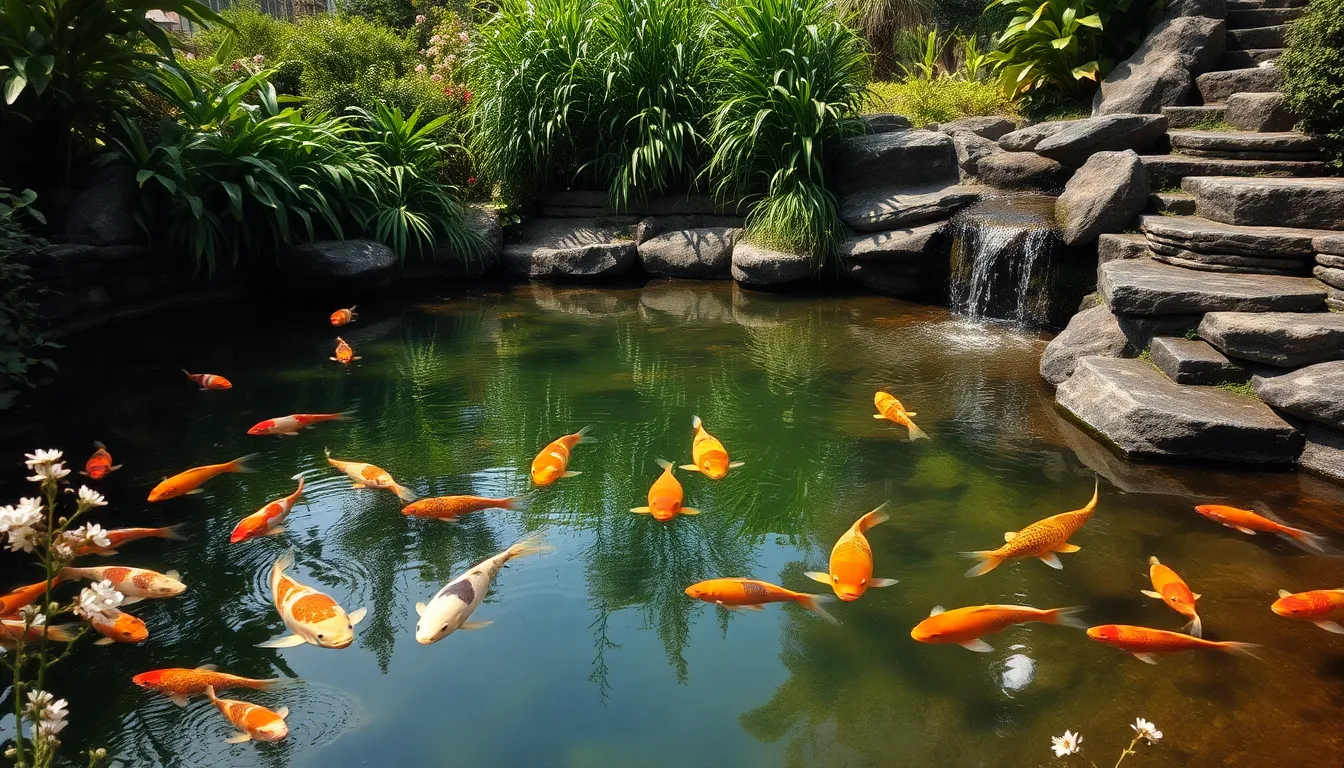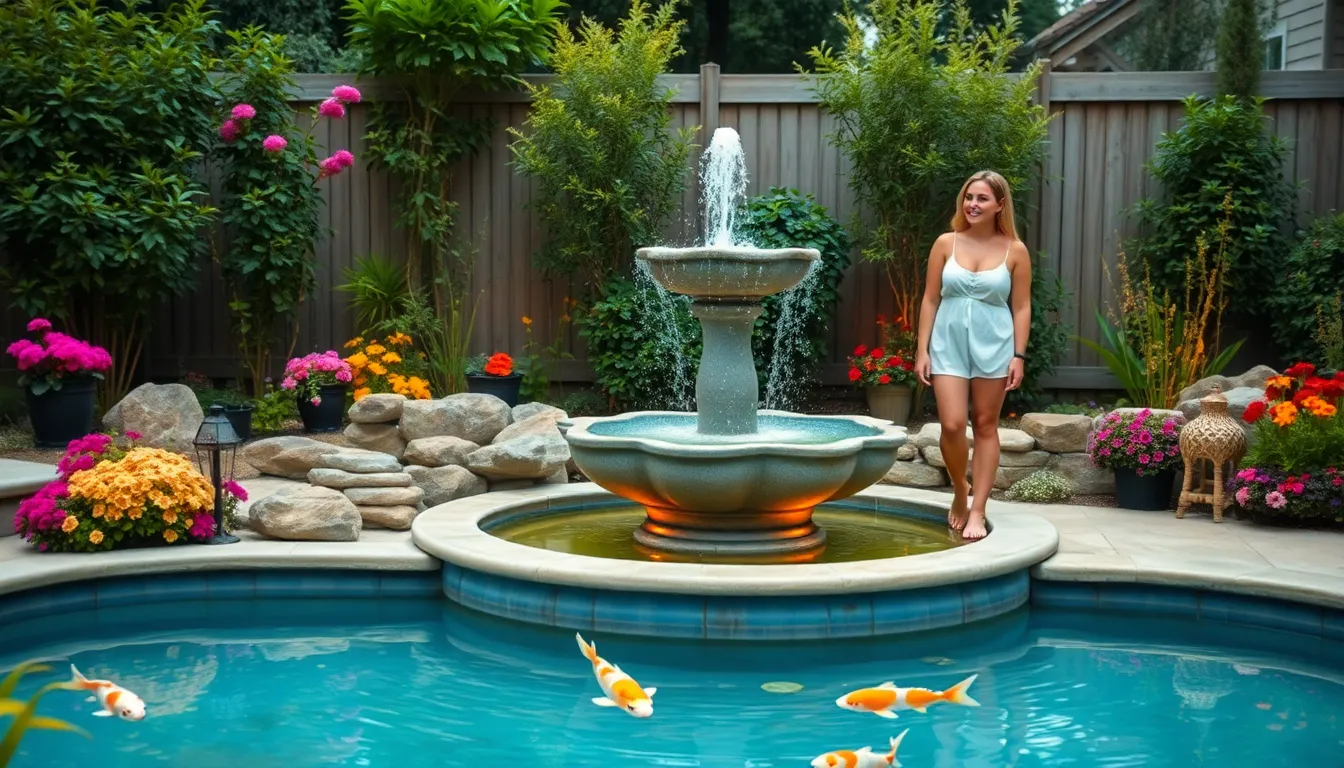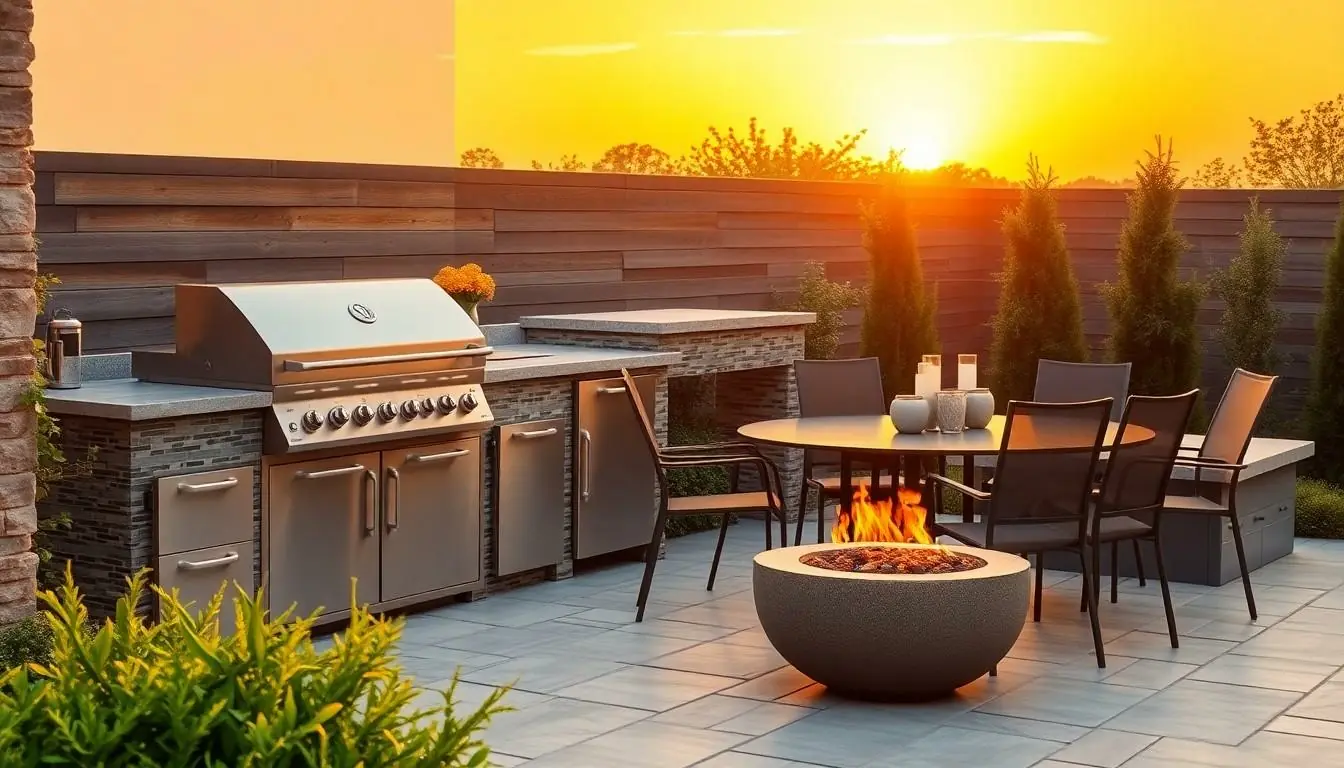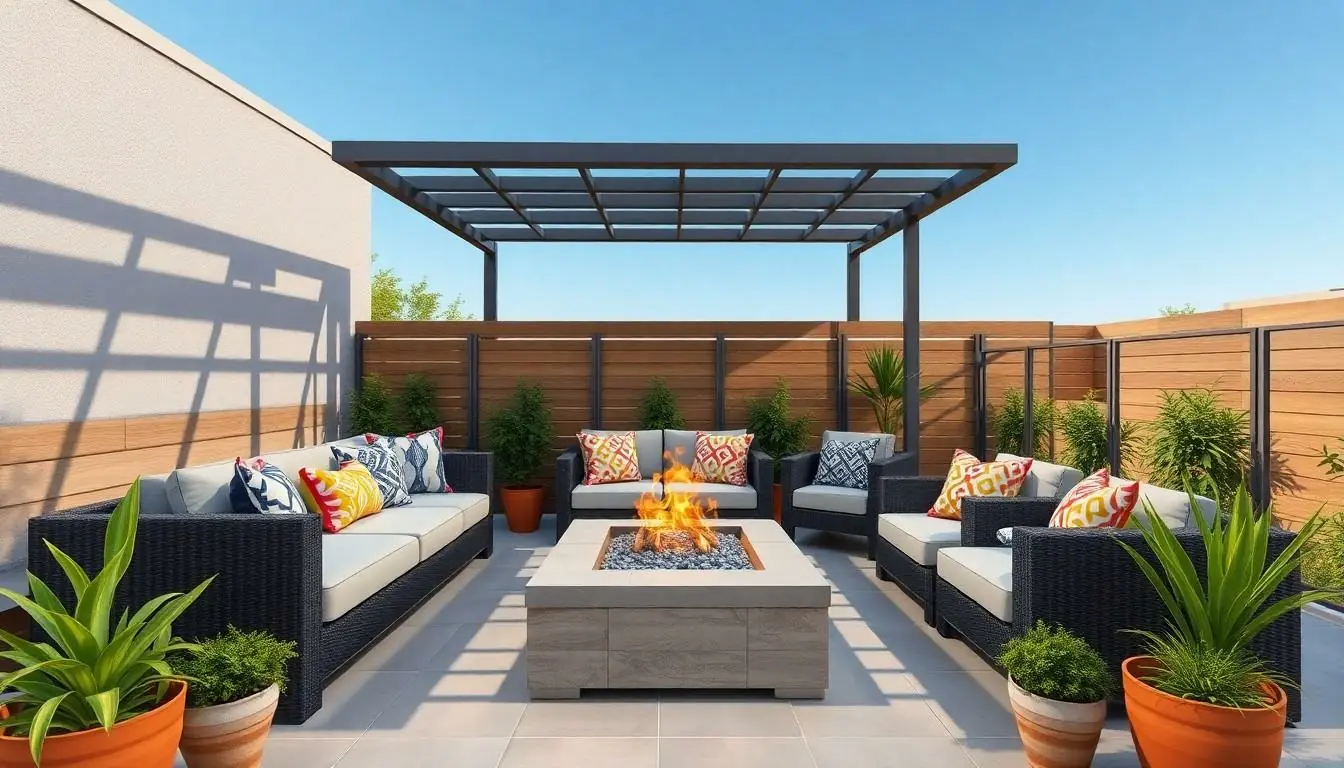Imagine stepping into your backyard and being greeted by the soothing sound of trickling water. A well-designed water feature can transform any outdoor space into a serene oasis, making it the envy of the neighborhood. Whether it’s a sleek modern fountain or a charming pond filled with koi, the right water feature adds beauty and tranquility, turning mundane moments into mini-vacations.
Table of Contents
ToggleOverview of Water Feature Design
Water feature design plays a critical role in enhancing outdoor spaces. This design element provides aesthetics and promotes relaxation and engagement with nature. Different types of water features exist, including fountains, ponds, waterfalls, and streams. Each option offers unique experiences and visual impact.
Fountains can serve as focal points in gardens and yards, drawing attention and admiration. Simple designs, such as wall-mounted units, integrate with limited spaces. Bigger, multi-tiered fountains create drama and artistry, inviting a sense of grandeur.
Ponds, on the other hand, offer tranquility and can host aquatic life. Koi ponds introduce colorful fish, creating a lively atmosphere. Aquatic plants enhance ecological balance and provide additional beauty. Consideration of size and shape is vital for a pond’s integration into the landscape.
Waterfalls add dynamic movement and sound to outdoor environments. Naturalistic designs blend seamlessly with rocks and plants. Artificially created waterfalls can incorporate lighting, adding charm during the evening. They promote a sense of privacy and seclusion when strategically placed.
Stream features mimic the soothing sounds of flowing water. This design can connect various elements within the landscape. Building a stream requires a clear vision of flow and containment to prevent water loss. Engineers often collaborate to ensure structural integrity and aesthetic appeal.
Incorporating lighting into water features enhances their allure during nighttime. Submersible lights illuminate fountains and ponds while highlighting plants. Maintenance of these installations is essential, ensuring water quality and equipment functionality. Regular care can elongate the lifespan of the water features.
Assessment of the overall environment is fundamental in water feature design. Elements such as surrounding foliage, hardscapes, and architectural styles influence the choice of features. Thoughtful design connects water features with the landscape, enriching the experience they provide.
Types of Water Features

Water features come in various forms, each offering unique benefits and aesthetic qualities. Understanding these options can help in selecting the perfect addition to enhance outdoor spaces.
Fountains
Fountains bring elegance and visual interest to gardens, patios, or yards. They come in various styles, from modern to traditional designs. Options like wall-mounted or freestanding fountains suit diverse spaces. Water flow creates soothing sounds that mask background noise, facilitating relaxation. Many fountains include integrated lighting, illuminating the flowing water at night, enhancing visual drama.
Ponds
Ponds add a serene quality to landscapes, providing a habitat for aquatic life. Shapes and sizes vary, accommodating different garden styles and preferences. Options include fish ponds, which attract colorful koi or goldfish, and naturalistic ponds that mimic ecosystems. Surrounding landscaping can complement the pond, creating a tranquil retreat. Regular maintenance and filtration systems ensure clean water, promoting a healthy environment for plants and fish.
Waterfalls
Waterfalls introduce movement and energy to outdoor spaces, often paired with ponds or streams. They simulate the soothing sounds of cascading water, enhancing relaxation. Various styles exist, from grand, multi-tiered designs to smaller, intimate features. Natural stone can provide a rustic look, blending seamlessly with garden elements. Well-placed lighting highlights the waterfall’s contours, creating enchanting nightscapes.
Streams
Streams create a dynamic flow of water that enriches landscapes with auditory and visual appeal. These features mimic natural watercourses, winding through gardens or landscapes. Incorporating stones and plants along the edges establishes a natural look, fostering tranquility. Stream designs can vary in size, from meandering paths to more straightforward, decorative borders. Their gentle sounds evoke a peaceful ambiance, making them a beautiful addition to any outdoor space.
Key Considerations in Water Feature Design
Designing water features involves careful planning and consideration of various factors. Effective design requires attention to site selection, budgeting, and environmental impact.
Site Selection
Site selection plays a crucial role in water feature design. Choose a location with good visibility and easy access for maintenance. Ensure that the area receives adequate sunlight, as this promotes healthy aquatic life and enhances visual appeal. Evaluate existing landscapes to complement the water feature. Consider proximity to trees to avoid debris buildup, which can hinder maintenance efforts. Lastly, assess drainage patterns to prevent water accumulation and optimize the feature’s functionality.
Budgeting
Budgeting determines the scope and quality of the water feature. Establish an initial budget that includes materials, labor, and ongoing maintenance costs. Various features, from simple fountains to elaborate koi ponds, come at different price points. Allocate funds wisely across design elements, including pumps, lighting, and landscaping. Prioritize investments that enhance durability and aesthetics while ensuring the long-term sustainability of the feature.
Environmental Impact
Environmental impact remains a key consideration in water feature design. Assess how the feature interacts with local ecosystems, as some species thrive in or around water. Opt for native plants to support biodiversity and reduce maintenance. Implement sustainable practices, such as using rainwater collection systems to minimize water usage. Evaluate how the feature contributes to overall ecosystem health, promoting responsible water management and habitat preservation.
Design Elements and Aesthetics
Water feature design incorporates various elements that enhance both functionality and beauty, creating harmonious outdoor spaces.
Materials and Construction
Choice of materials influences durability and aesthetics. Natural stone creates an organic feel, while concrete allows for modern designs. Metal elements can add a contemporary touch. Consideration of local materials ensures that water features blend with the surroundings. Each material requires specific construction methods that impact the design’s longevity and maintenance requirements.
Plant Integration
Integration of plants enhances visual appeal and supports wildlife. Native plants thrive in local conditions and provide necessary habitats. Select aquatic plants like water lilies or cattails for ponds, and ornamental grasses for surrounding areas. Creating layers of vegetation establishes depth. This approach not only beautifies water features but also maintains ecological balance.
Lighting Design
Effective lighting elevates water features, enhancing ambiance at night. LED lights offer energy efficiency and various color options. Strategically placed lights highlight movement and texture, drawing attention to focal points. Light placement can create reflections on the water’s surface, enhancing the visual experience. Combining soft ambient lighting with accent lighting creates a dynamic nighttime atmosphere.
Maintenance and Care
Regular maintenance ensures that water features remain beautiful and functional. Attention to both seasonal tasks and common issues can prolong their lifespan and enhance enjoyment.
Seasonal Maintenance
Seasonal maintenance is vital for water features. Spring cleaning involves removing debris and checking for damage. Summer requires regular water level checks due to evaporation. In fall, clearing leaves prevents clogging and maintains aesthetics. During winter, especially in colder climates, it’s important to properly winterize ponds and fountains. This may include draining water features or adding de-icing equipment. Each season brings specific tasks that protect the investment and keep the feature performing well.
Troubleshooting Common Issues
Troubleshooting common issues in water features promotes longevity. Algae growth often signals poor water circulation or inadequate filtration. To combat algae, consider increasing filtration and introducing aquatic plants that shade the water. Murky water can indicate a buildup of debris or low oxygen levels. Cleaning filters and ensuring proper aeration usually resolves this. If a pump malfunctions, checking for clogs or debris helps restore functionality. These simple steps can address frequent problems and maintain the beauty of outdoor water features.
Water features can truly elevate outdoor spaces into serene retreats. By thoughtfully incorporating elements like fountains ponds and waterfalls one can create a harmonious environment that promotes relaxation and beauty.
Considering factors such as site selection materials and maintenance ensures that these features not only enhance aesthetics but also support local ecosystems. With the right design and care water features can transform any backyard into a tranquil oasis where every moment feels special. Embracing these elements will lead to a more enjoyable outdoor experience for everyone.







